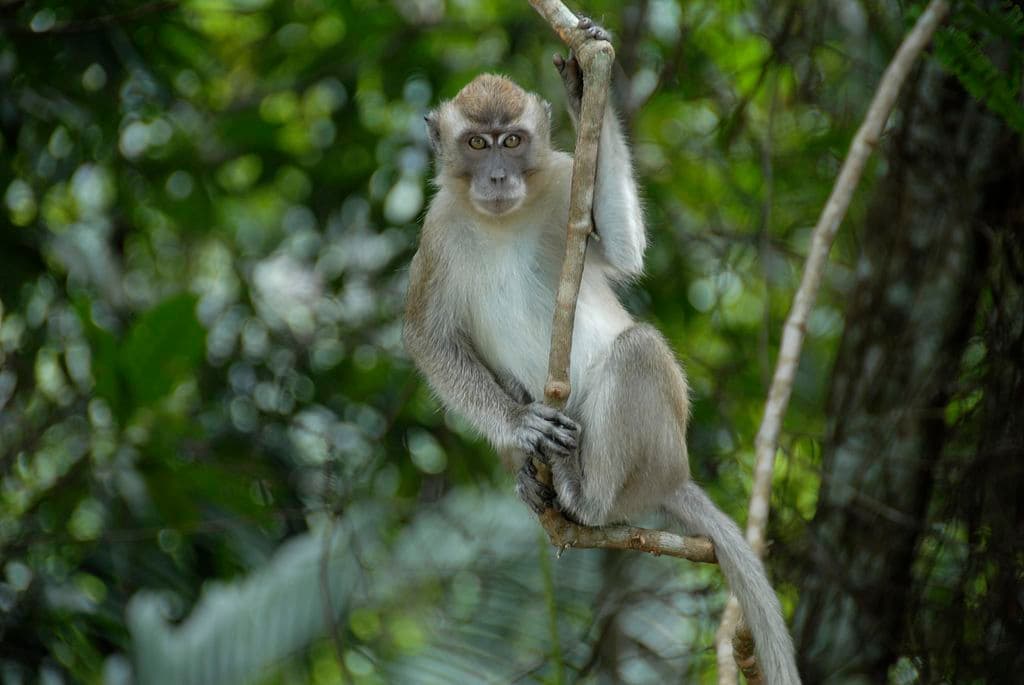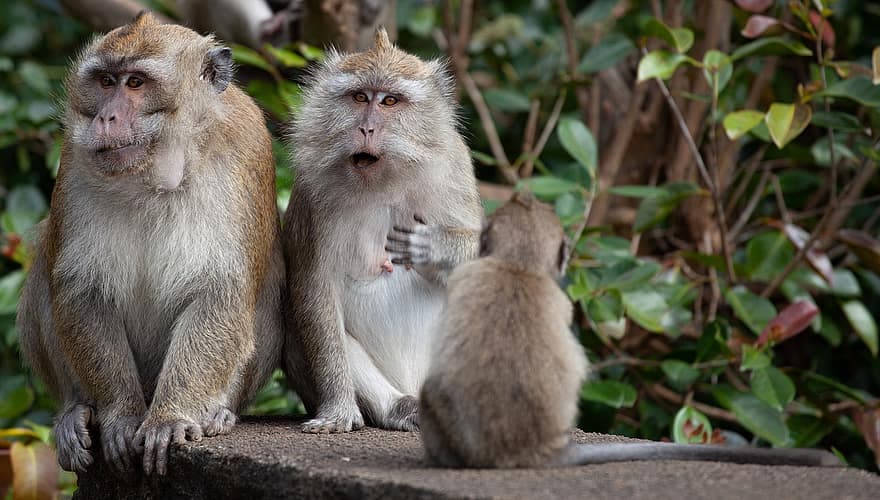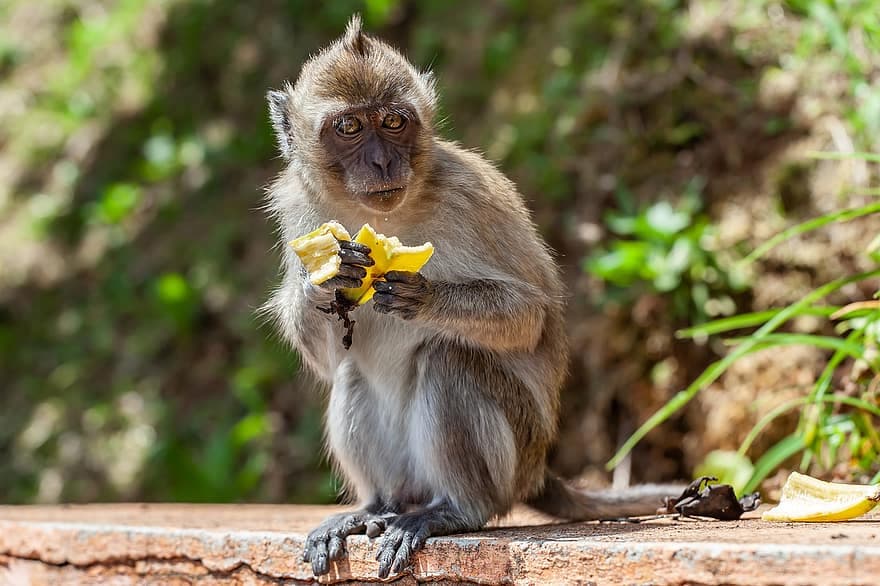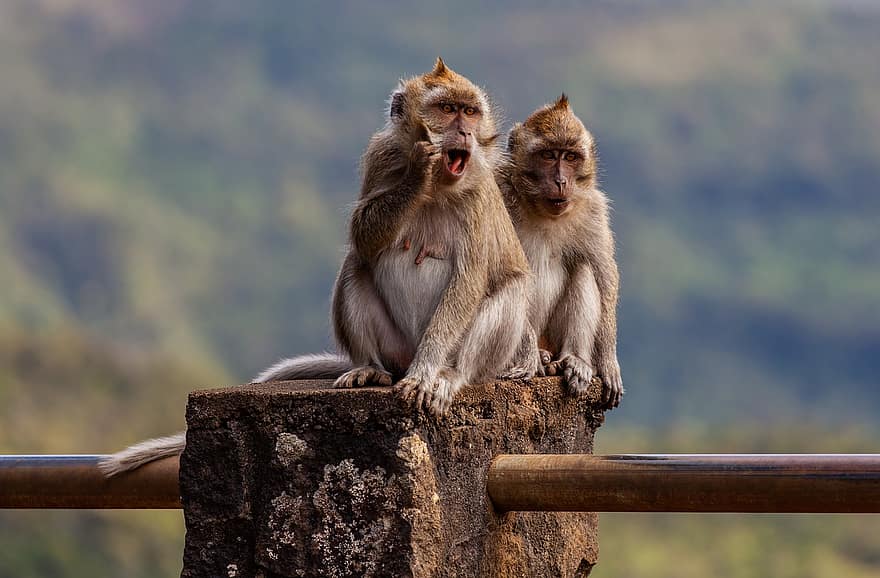The long-tailed macaque aka crab-eating macaque (ស្វាក្តាម) is one of the most interesting primates with a long history alongside humans. With centuries of existence, different cultures also view them differently; agricultural pests, sacred animals, or worse, subjects of medical experiments. This is also why these macaques are also referred to as lab monkeys. There are so many other things about them that we don’t know so let’s find out with me below.
Appearance

A long-tailed macaque can grow from 38 to 55 centimeters but they have relatively short arms and legs. Males are usually larger than females but both sexes have tails that are from 40 to 65 centimeters long. The tails are either dark gray or brown in color. Many people also call them long-tailed macaques because of the length of their tails which are longer than their bodies. These macaques use their tails for balance when they jump, often at distances of up to 5 meters.
The upper parts of their bodies are dark brown with light golden brown tips, and the underparts are light gray. Their faces are pink with yellow-brown eyes and large square ears. On their eyelids are prominent white markings, and sometimes there are also white spots on their ears. You can differentiate males and females by their cheek whiskers and mustache because females lack the mustache. However, both males and females have a cheek pouch that they use to store food while foraging.
Behavior

Not different from other primates, long-tailed macaques communicate by using facial expressions, gestures, and vocalizations (barks, contact calls, grunts, screams, etc). Normally, long-tailed macaque lives in matrilineal social groups of up to 8 individuals dominated by females. When male members reach maturity, they will leave the group. One of the fascinating parts is that they also observe engaging in grooming with other primate species. Some of those are dusty langur, Raffles’ banded langur, and southern pig-tailed macaques.
The coolest thing about them is that some crab-eating macaques use stone tools to open nuts, oysters, and other bivalves. On top of that, they also clean their food before consuming them as well. They either rub food through their hands or wash their food by soaking them in water, usually cassava roots, papaya leaves, and sweet potatoes. The best part is that adolescents acquire such behaviors by observing older individuals within their groups.
Feeding & Habitats

The name crab-eating macaques already told you one of their common meals, crabs. These macaques are often seen foraging on beaches for crabs; however, they are primarily frugivorous and opportunistic omnivores. Fruits and seeds make up 60% to 90% of their diet, and they also consume bark, flowers, leaves, and roots. Besides crabs, they also prey on vertebrates like bird chicks, crustaceans, fish, frogs, lizards, nesting female birds, and more. For those who live in cities, towns, and villages, they frequently take food from garbage and refuse piles. Plus with the fact that they are not afraid of humans, they also aggressively or passively take food from people directly.
Crab-eating macaques’ range is across most of mainland Southeast Asia, inhabiting various areas both on land and by the water. Some of their common habitats are bamboo forests, deciduous forests, evergreen forests, primary lowland rainforests, scrub grasslands, secondary rainforests, and shrublands. The water habitats are coastal forests of mangrove and nipa palm, freshwater swamps, and riverine. These primates actually prefer disturbed habitats and forest periphery which is somehow peculiar. Another interesting thing is that they can easily adjust to human settlements so it is not uncommon to see them.
Pests
Crab-eating macaques are invasive species in Hong Kong and Western New Guinea that pose threats to biodiversity in several locations. Mostly, people consider them as pests around farms and villages. In Mauritius, this macaque species is a threat for the endemic and endangered Roussea simplex because they destroy the plants’ flowers. At the same time, they also compete with the endemic endangered Mauritian flying fox for native fruits as well. This is why they are captured and sold to the pharmaceutical industry in Mauritius. However, they are considered sacred at some Hindu temples and on some small islands. Along with that, their populations also overlap in human living space due to habitat loss.
Status
Long-tailed macaques are considered endangered on the IUCN Red List due to a severe population decline in just two years. The main threats to their number are hunting, trapping, and troublesome interactions with humans. While having great adaptability and wide range, these threats affect their population greatly. More than that, they are also used by the medical industry during the Covid-19 pandemic for study purposes. They have been subjects in biomedical research way before the pandemic but the pandemic harmed their population even more.
Related Post: Things You Don’t Know About Greater Hog Badgers
